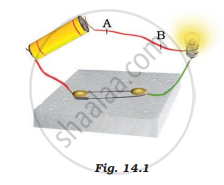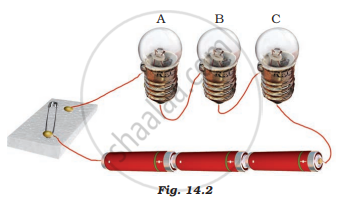Advertisements
Advertisements
प्रश्न
Explain about domestic electric circuits. (circuit diagram not required)
उत्तर
In our homes, electricity is distributed through the domestic electric circuits wired by the electricians. The first stage of the domestic circuit is to bring the power supply to the main box from a distribution panel, such as a transformer. The important components of the main box are: (i) a fuse box and (ii) a meter. The meter is used to record the consumption of electrical energy. The fuse box contains either a fuse wire or a Miniature Circuit Breaker (MCB). The function of the fuse wire or an MCB is to protect the household electrical appliances from overloading due to excess current.
An MCB is a switching device, which can be activated automatically as well as manually. It has a spring attached to the switch, which is attracted by an electromagnet when an excess current passes through the circuit. Hence, the circuit is broken and the protection of the appliance is ensured.
The electricity is brought to houses by one wire that has red insulation and is called the ‘live wire’. The other wire has black insulation and is called the ‘neutral wire’. The electricity supplied to your house is actually an alternating current having an electric potential of 220 V. Both, the live wire and the neutral wire enter into a box where the main fuse is connected with the live wire. After the electricity meter, these wires enter into the main switch, which is used to discontinue the electricity supply whenever required. After the main switch, these wires are connected to live wires of two separate circuits.
Out of these two circuits, one circuit is of a 5 A rating, which is used to run the electric appliances with a lower power rating, such as tube lights, bulbs, and fans. The other circuit is of a 15 A rating, which is used for two insulated wires. Out of these two wires, run electric appliances with a high power rating, such as air-conditioners, refrigerators, electric iron, and heaters. It should be noted that all the circuits in a house are connected in parallel so that the disconnection of one circuit does not affect the other circuit. One more advantage of the parallel connection of circuits is that each electric appliance gets an equal voltage.
APPEARS IN
संबंधित प्रश्न
What do the following symbols mean in circuit diagrams?

Draw a circuit diagram to show how 3 bulbs can be lit from a battery so that 2 bulbs are controlled by the same switch the third bulb has its own switch.
In an electric circuit, electron flow a from of point of ______ potential to the point of ______ potential.
If you touch an electric wire carrying current you get a shock, but if on the same wire the birds sit they do not get any shock/current. Explain why?
Higher Order Question
A student made a circuit by using an electric cell, a switch, a torch bulb (fitted in the bulb holder), and copper connecting wires. When he turned on the switch, the torch bulb did not glow at all. The student checked the circuit and found that all the wire connections were tight.
- What could be the possible reason for the torch bulb not glowing even when the circuit appears to be complete?
The wiring in a house consists of ______ circuits.
When an electric current flows through a copper wire AB as shown in Figure14.1, the wire

Choose the statement which is not correct in the case of an electric fuse.
Three bulbs A, B, and C are connected in a circuit as shown in Figure 14.2. When the switch is ‘ON’

How is Joule's law effect useful in electric circuits where fuse is used as a safety device?
